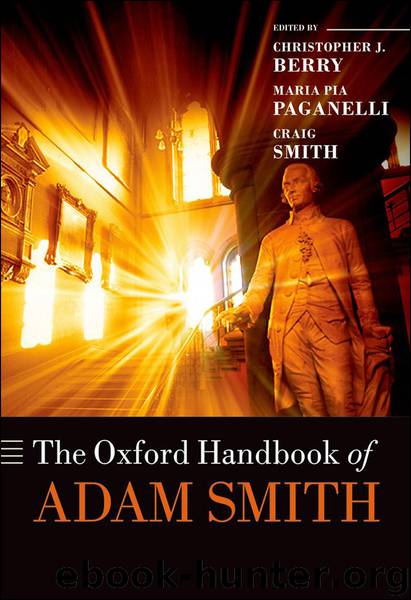Adam Smith by Christopher J. Berry & Maria Pia Paganelli & Craig Smith

Author:Christopher J. Berry & Maria Pia Paganelli & Craig Smith
Language: eng
Format: epub
Publisher: Oxford University Press
Published: 2013-03-14T16:00:00+00:00
CONCLUSION
Adam Smith believed in natural liberty as a good working rule for economic policy, a rule supported by his broad and deep reading of economic history, and by the information he derived from his broad network of contemporary contacts in business and academia. But since this was indeed a ‘working’ rule, he was willing to modify it in the face of solid evidence. Nowhere is this clearer than in his prescriptions for money and banking. The private competitive banking system in Scotland had proved that a relatively free private banking system would promote economic growth. But the Ayr Bank crisis and the ‘small note mania’ showed that banking needed regulation. Prohibitions on the issue of small notes and notes bearing the option clause were needed to protect the poor. Usury laws that set the maximum rate of interest above, but only slightly above, the prevailing market rate were needed to divert capital from ‘prodigals and projectors’ to ‘sober men of business’. And banks needed to follow the ‘real bills doctrine’ and avoid long-term investments, such as investments in real estate. Smith envisioned a monetary system consisting of a competitive, privately owned banking system erected on a base of gold and silver. True, there had been successful government emissions of redeemable paper currencies, and some foreign government owned central banks had managed the trick. However, the few experiments with pure fiat currencies with which he was familiar—John Law’s experiment in France, some of the legal-tender paper money issues in the American colonies—showed that governments needed to be prevented from issuing monies based simply on being legal tenders; a pure fiat money was likely to be over-issued. Smith’s precise recommendations cannot be followed in today’s world. Indeed, economic historians have challenged some of his readings of monetary history on which Smith based his judgments. But Smith’s remarkable willingness to learn from the historical evidence, both when it supported laissez faire, and when it called for regulation, still sets an admirable example.17
Download
This site does not store any files on its server. We only index and link to content provided by other sites. Please contact the content providers to delete copyright contents if any and email us, we'll remove relevant links or contents immediately.
International Integration of the Brazilian Economy by Elias C. Grivoyannis(90729)
The Radium Girls by Kate Moore(11921)
Turbulence by E. J. Noyes(7935)
Nudge - Improving Decisions about Health, Wealth, and Happiness by Thaler Sunstein(7615)
The Black Swan by Nassim Nicholas Taleb(7010)
Rich Dad Poor Dad by Robert T. Kiyosaki(6399)
Pioneering Portfolio Management by David F. Swensen(6226)
Man-made Catastrophes and Risk Information Concealment by Dmitry Chernov & Didier Sornette(5921)
Zero to One by Peter Thiel(5684)
Secrecy World by Jake Bernstein(4643)
Millionaire: The Philanderer, Gambler, and Duelist Who Invented Modern Finance by Janet Gleeson(4374)
The Age of Surveillance Capitalism by Shoshana Zuboff(4209)
Skin in the Game by Nassim Nicholas Taleb(4161)
Bullshit Jobs by David Graeber(4094)
The Money Culture by Michael Lewis(4074)
Skin in the Game: Hidden Asymmetries in Daily Life by Nassim Nicholas Taleb(3929)
The Dhandho Investor by Mohnish Pabrai(3698)
The Wisdom of Finance by Mihir Desai(3650)
Blockchain Basics by Daniel Drescher(3495)
